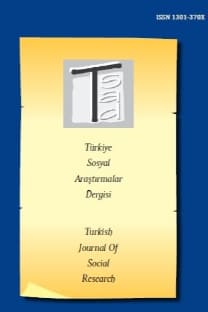SIĞINMACI ÇOCUKLAR İÇİN OYUN İMKANI SAĞLAMAK: YEREL YÖNETİMLERE TASVİYELER ÜZERİNE BİR TARIŞMA
Sığınmacı çocuklar, oyun imkanları, belediyelerin rolü, stratejiler
CREATING PLAY OPPORTUNITIES FOR REFUGEE CHILDREN: A DISCUSSION ON ADVISES TO LOCAL AUTHORITIES
Refugee children, play opportunities, role of municipality, strategies,
___
- Dedeoğlu, S. (2012) Göç ve hayatta kalma mücadelesi: İstanbul’da Azerbaycanlı kadın göçmenlerin hayatta kalmamücadelesi ve endüstriyel üretim. Migr. Lett. 9, 365 – 372.
- Fletcher, K. E.; Barkley, Russell A. (2003). "7". In Mash, Eric J. Child psychopathology (2nd ed.). New York: Guilford Press. pp. 330–371. ISBN 1-57230-609-2.
- Ginsburg, K.R., (2007) The Importance of Play in Promoting Healthy Child Development and Maintaining Strong Parent-Child Bonds. Pediatrics, 119(1), pp.119–182.
- Göç İdaresi Genel Müdürlüğü. (2015) Türkiye ve Göç. T.C. İçişleri Bakanlığı Göç İdaresi Genel Müdürlüğü, Ankara.
- Güçer, M., Karaca, S. & Dinçer, B. (2013) Sınırlar Arasında Yaşam Savaşı: Suriyeli Mülteciler Alan Araştırması. Uluslararası Stratejik Araştırmalar Kurumu, USAK Rapor No: 13–14, Mayıs 2013.
- Haight, W.L. & Black, J.E., (2001) A comparative approach to play: Cross-species and cross-cultural perspectives of play in development. Human development, 44(4), pp.228–234.
- Hurtwood, L.A. of, (1968). Planning for Play, Norwich: Jarrold&Sons.
- Kavlak, İ. V. (ed) (2011) Askıdaki Yaşamlar & Algıdaki Yaşamlar Projesi Araştırma Raporu. Sığınmacı ve Göçmenlerle Dayanışma Dernegi. Atik Matbacılık, Ankara.
- Kinoshita, I. & Woolley, H., (2015) Children’s Play Environment after a Disaster: The Great East Japan Earthquake. Children, 2(1).
- Kirişçi, K. (2014) Misafirliğin ötesine geçerken Türkye’nin “Sureyeli Mülteciler” sınavı. Brookings Enstitüsü / Uluslararasi Strateji̇k Araştırmalar Kurumu (USAK).
- Kılıç, T. et al. (2015) Türki̇ye’de mülteci̇leri̇n kabul koşullari hak ve hi̇zmetlere eri̇şi̇mleri̇. Uydu Kentler İzleme ve Raporlama Projesi, Mültecilerle Dayanışma Derneği. Egeus Matbacılık, Izmir.
- Kolb, A.Y. & Kolb, D.A., (2010) Learning to play, playing to learn A case study of a ludic learning space. Journal of Organizational Change Management, 23(1), pp.26–50.
- Kucukali, A., (2015) Çocukların oyun oynama hakkı ve değişen oyun kültürü. Erzincan Üniversitesi Sosyal Bilimler Enstitüsü Dergisi (ERZSOSDE), 8(1), pp.1–14.
- Lisul, I., (2004) Play as a coping strategy during a time of bombing and destruction. In R. L. Clements & L. Fiorentino, eds. The Child’s Right to Play. Westport, USA: Greenwood Publishing Group, pp. 55–61.
- Machel, G., (2001) The impact of war on children, London: Hurst & Co.
- Manwaring, B. & Taylor, C., (No date) The Benefits of Play and Playwork.
- Murat, M. E. (2017) Urban Refugees From ‘ Detachment ’ To ‘ Harmonization ’ - Syrian Refugees and Process Management of Municipalities: The Case of Istanbul. Marmara Belediyeler Birliği Kültür Yayınları, Ocak 2017.
- NPFA, (2000) Best Play: What play provision should do for children, London: National Playing Fields Association.
- Sarıkaya, M. (2016) Türkiye’deki mülteci kamplarında günde 125 çocuk doğuyor. Habertürk, Mart 2016.
- UNHCR (2011) UNHCR Statistical Year Book 2011.
- UNHCR (2013) Mid-Year Trends 2013 report, United Nationas High Comissioner for Refugees, Geneva.
- UNHCR (2015a) Mid-Year Trends 2014report, United Nationas High Comissioner for Refugees, Geneva.
- UNHCR (2015b) Mid-Year Trends 2015 report, United Nationas High Comissioner for Refugees, Geneva.
- UNHCR (2017) Mid-Year Trends 2016 report, United Nationas High Comissioner for Refugees, Geneva.
- UNICEF (2012) Syria Crisis bi-weekly 2012 Annual Situation Report.
- UNICEF (2014) Syria Crisis 2014 Annual Situation Report.
- UNICEF (2016) Syria Crisis: February 2016 Humaniterian Results. Wethington, et. al. (2008). "The Effectiveness of Interventions to Reduce Psychological Harm from Traumatic Events Among Children and Adolescents". American Journal of Preventive Medicine. 35 (3): 287-313.
- WHO (2015) World Health Organization: Physical activity and young people.
- Woolley, H. & Kinoshita, I., (2015) Space, People, Interventions and Time (SPIT): A Model for Understanding Children’s Outdoor Play in Post‐Disaster Contexts Based On a Case Study from the Triple Disaster Area of Tohoku in North‐East Japan. Children & Society, 29(5), pp.434–450.
- Internet Resources:
- Internet 1: Hidden Child Labour: How Strian refugees in Turkey are supplying Europe with fast fashion, Guardian 29 January 2016. Available at: https://www.theguardian.com/sustainable-business/2016/jan/29/hidden-child-labour-syrian-refugees-turkey-supplying-europe-fast-fashionç Accessed 22. 08.2017. [Accessed: 10 June 2017].
- Internet 2: No Lost Generation: 2016 Syria Crisis update. Available at: http://data.unhcr.org/syrianrefugees/download.php?id=10210. [Accessed 25.08.2017].
- Internet 3: Humanium, (2016). Children’s Rights History: Historical overview of the Children’s rights evolution. Available at: http://www.humanium.org/en/childrens-rights-history/. [Accessed: 15 July 2017].
- Internet 4: Tucker, J., (2014) Kids with PTSD find help through adventure-based therapy. Available at: http://www.sfgate.com/bayarea/article/Kids-with-PTSD-find-help-through-adventure-based-5436668.php. [Accessed: 20.08.2017].
- ISSN: 1301-370X
- Başlangıç: 2015
- Yayıncı: AKADEMİSYENLER BİRLİĞİ DERNEĞİ
İstem KESER, Rahime Burcu KART
ÜNİVERSİTESİ ÖĞRENCİLERİNİN ZAMAN YÖNETİMİNDE DÜŞTÜKLERİ ZAMAN TUZAKLARI VE BUNLARLA BAŞETME YOLLARI
VAROLUŞÇU PSİKOLOJİK DANIŞMA VE PSİKOTERAPİ: TEORİ VE PRATİĞİ
Mehmet Zeki İLGAR, Semra COŞGUN İLGAR
TÜRKİYE’DE CARİ AÇIĞIN FİNANSMAN YAPISI ve SÜRDÜRÜLEBİLİRLİĞİ: EKONOMETRİK BİR ANALİZ
ÜNİVERSİTE ÖĞRENCİLERİNİN ZAMAN YÖNETİMİNDE DÜŞTÜKLERİ ZAMAN TUZAKLARI VE BUNLARLA BAŞETME YOLLARI
GRUPLAR ARASI TEMAS VE ÇAPRAZ EVLİLİKLER: İZMİR'DE ALEVİ-SÜNNİ EVLİLİKLERİ
Gül ÖZATEŞLER ÜLKÜCAN, Abbas TÜRNÜKLÜ, Özge ERARSLAN İNGEÇ, Sedef TULUM AKBULUT
SIĞINMACI ÇOCUKLAR İÇİN OYUN İMKANI SAĞLAMAK: YEREL YÖNETİMLERE TASVİYELER ÜZERİNE BİR TARIŞMA
TEMEL EĞİTİM DERS KİTAPLARINDA AFET OLAYLARI İLE İLGİLİ KAVRAMLARDA GÖRÜLEN EKSİKLİKLER
